lies like truth: October 2010 Archives
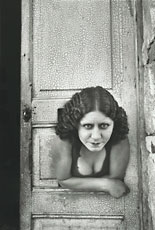 I've had the good fortune to experience so many cultural happenings this week that I'm quite behind on my commentary about them all. Just thought I'd use this opportunity to provide a quick roundup of three arts events that anyone in SF with a bit of cash to spend and some time on their hands should make a bee-line for:
I've had the good fortune to experience so many cultural happenings this week that I'm quite behind on my commentary about them all. Just thought I'd use this opportunity to provide a quick roundup of three arts events that anyone in SF with a bit of cash to spend and some time on their hands should make a bee-line for:1. Westside Story at the Orpheum Theatre: The new Broadway tour of the Bernstein classic is worth seeing simply as a reminder of the musical's superiority to almost any contemporary counterpart. Almost every song is a hit. The choreography is virile and virtuostic. The orchestrations hit you in the gut. The characters are vivid. I only wish that the singing in this production were better. The nasal quality of Ali Ewoldt's voice as Maria made my toes curl. And Kyle Harris, the production's handsome Tony, could barely reach the many high notes in his songs.
2. Henri Cartier-Bresson exhibition at the San Francisco Museum of Modern Art (and "Exposed"): The highlight of this major retrospective of the famed photographer's career is the section devoted to the artist's travels through American in the post-war years. This material isn't as well known as much of Cartier-Bresson's other works, but the images are as vivid as the best of his iconic street-life pictures taken earlier in the century in France and elsewhere. There's a great photograph of a large family lounging all over a hatchback car in 1970 New Mexico. The car becomes the ultimate leisure vehicle. It's like the family's lounge. Another image I like is a photograph taken in San Francisco in 1960. It's a view from above of ladies sitting next to each other with tightly-crossed legs. The legs look like features of the landscape rather than anatomical parts. Cartier-Bresson's widow, the photographer Martine Franck, was at the opening at SFMOMA. There are two pictures of her in the exhibition. At one point, I noticed her stopping to steal a glance at one of her husband's photographs of her. It was just a second's pause. Then she moved on, spending much more time in front of the other portraits. A photography exhibition on the floor above the Cartier-Bresson show, "Exposed", all about the different ways in which people see and are seen by the camera's eye, is also very much worth a visit. The images range from the sexual (eg a Helmut Newton image taken through a mirror of him posing with a couple of naked female models and a clothed female) to the celebrity (eg an image of the Queen with her corgies) to the violent (countless horrifying pictures of lynchings, amputees, suicides and so on). The breadth and unflinching nature of the material make the show feel both compact and powerful.
3. Kronos Quartet at Yerba Buena Center for the Arts: The Bay Area's preeminent experimental string quartet is embarking on a long-term partnership with YBCA. The group kicked off the relationship with a concert of short works featuring live string music set against a backdrop of ambient recorded and electronic noise and a new production of a spellbinding 1970 work by George Crumb entitled Black Angels. The first half of the program felt quite samey to me, even though there are great contrasts in mood between Bob Ostertag's furious "All the Rage", a piece about homophobia, Ingram Marshall's creeping "Fog Tropes II", the Middle Eastern-inflected lines of Sahba Aminikia's "String Quartet No 3: A Threnody for Those who Remain" and Aleksandra Vrebalov's stormy "Spell No 4 for a Changing World." But it was the second half that really entranced me. The theatricailty of the new staging was startling, with its ceremonial hanging of the string instruments on bungies that look like tiny noose. I was also enraptured by the diversity of the musical influences which ranged from Schubert's Death and the Maiden quartet to a Renaissance sarabande to Asian scales. I'm not sure why, but as the musicians glided through this piece, I felt like I was receiving information about a variety of ancient and now lost, dormant cultures. I listened like a sleepwalker.
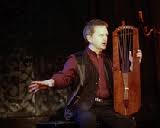 I like seeing performances in languages I barely understand or don't understand at all.
I like seeing performances in languages I barely understand or don't understand at all.This feeling came back to me a couple of nights ago when I was in Berkeley seeing a great interpreter of Anglo-Saxon stories and music, Benjamin Bagby, perform Beowulf in the old English in which the epic poem was originally set down in writing centuries ago.
Supertitles are obviously helpful. But, just as with some of the best theatrical productions I've experienced in my time in Russian, German and a variety of Indian tongues that didn't provide assistance with translations, I don't believe the supertitles significantly increased my enjoyment of the show.
Bagby is such a consummate storyteller: The intensity of his gaze and his delicate harp accompaniment, speech modulations and emotional, lusty singing voice conveyed a great deal of meaning. It is sufficient, I think, to go into the theatre with a general understanding of the plot of Beowulf. Parsing every word isn't necessary for one's enjoyment. I was completely transported by the performer's narrative.
In other news: A friend of mine who lives on the other side of the country saw my recent New York Times piece about the Bay Area cabaret scene and was inspired to write to me about his experiences in a not-very-authentic martini bar in Traverse City. I'm hopeless on the theme of cocktails. I'm a wine drinker almost exclusively, so asked for John's help in knowing how to order a martini next time I go to the Venetian Room at the Fairmont Hotel to see Chita Rivera -- and what to expect.
John's advice was so artfully articulated that I asked him if I could share it on my blog and he agreed. Here it is:
A real Martini is not made with strawberry juice or Cointreau or as in any other of the frou frou girly monstrosities. If you go into the Cabaret in the Fairmont and ask for a classic martini with Bombay Sapphire gin, Tanqueray,Hendricks or one of the other top shelf gins and you want it say 10:1 or 16:1 you will get a classic martini. Vodka came much later in Martini history. Many persons who say they want a martini really only want gin or vodka straight, with the garden vegetables. They will only allow vermouth in the same room, but no closer. Try it in the above proportions and you will find a very nice blend of flavors ( but see below). Observe the bartender. If she/he macerates the lemon peel ( no flesh) and rubs it on the rim and puts a tiny bit of the juice from the olive jar in the drink with the olive, you will get a sense that she/he knows how to make one. If you ask for just a drop of single malt scotch in with the gin and vermouth, you will be noted as a cognascente. It should be served very cold. If you have your 3" stilettos on and one leg over the other on a stool at the bar make sure you get it "up", that is in a icy chilled conic section stem glass. If you are going to hunch over the bar or be at a table, then I guess an old fashion glass will work. In any event don't chug it but drink it while it is still cold. Warm martinis are deathly. The drop of single malt came from the bartender at the Oak Bar, or so my father said. It really rounds out the taste. The limit on Martinis is well established at 2, that is 2. Beyond that you are asking for trouble. I recommend that you round out your education in Britishness by hieing yourself to the library and borrowing a copy of Ian Fleming's Casino Royale. Therein lies the origin of the phrase "Shaken not stirred". Martinis are delicious with a doz. raw oysters. Life just cannot get much better.
 The all-male, a cappella vocal ensemble Clerestory was one man down for last Saturday's concert in Berkeley. The ensemble usually has nine members. That night, thanks to some last-minute redistribution of parts and the wise decision to move one piece forward in the program and cut another entirely, the men of Clerestory acquitted themselves exceedingly well with eight. (Countertenor Jesse Antin, a key member of the group, had suffered a family bereavement and had to leave town at short notice.)
The all-male, a cappella vocal ensemble Clerestory was one man down for last Saturday's concert in Berkeley. The ensemble usually has nine members. That night, thanks to some last-minute redistribution of parts and the wise decision to move one piece forward in the program and cut another entirely, the men of Clerestory acquitted themselves exceedingly well with eight. (Countertenor Jesse Antin, a key member of the group, had suffered a family bereavement and had to leave town at short notice.)Regardless of this fact, the event was to my mind a model of what a great choral concert should be. Here's why:
1. Many choruses, even good ones, outstay their welcome, thinking that audiences are desperate to sit through an entire mass and about 20 other pieces. But Clerestory's concert, which featured a selection of mini song cycles and short individual songs organized around a single theme, was just the right length.
2. There was a little bit of casual talk from the stage in between a few of the songs. The choir members spoke to us comfortably like we were friends. They didn't ramble, over-articulate as if speaking to a group of toddlers of the hard of hearing (which is so often the case in choral concerts) or preach to us. The information they imparted was helpful and concise.
3. The theme for the concert, "Night Draws Near" (also the title of the group's new CD) tackled the popular Halloween-time subject of death, decay, the cycles of nature and related ideas, in a fresh way. The music veered between a short movement from a Medieval Requiem Mass by Claudin de Sermisy and "Three Short Elegies" by the 20th century composer Gerald Finzi to the contemporary Finnish composer Jaako Mantyjarvi's ghoulish setting of "Double, Double Toil and Trouble" from Shakespeare's Macbeth and an electrifying battle song, "War Music: On Horseback," by the contemporary Bay Area-based, British composer Paul Crabtree. In other words, the ensemble's broad approach to programming had a cumulative effect on the listener: The singers tackled their chosen theme with breadth so I never got bored. On the other hand, the choice or repertoire was so inspired and the singing so beautiful, that I felt the kind of depth of connection with the music and people in the room that I more often feel when a concert is more narrow and focused in scope.
4. The intonation was perfect and full of emotion yet restrained when it needed to be. The sound was gorgeously balanced and the singers evoked a wide variety of moods.
If there's anything that didn't work quite right in the program, it was the contemporary composer John Musto's "Nunc Dimitis/The Birds Have Vanished". The decision to move this languorous, knotty, and sustained piece from the finale position forwards in the second half was a good one: The singers didn't want to leave it to last because of the difficulty of singing it without their ninth member on stage. And their lack of confidence in being short of one vocalist showed in the slightly hesitant nature of their performance.
But even with Antin on stage, I don't think that Musto's work would make for a good finale. I'm guessing that the group put it there because they wanted a quiet and thoughtful ending to the program. When I listened to a recording of the track on the group's new CD the following day, the composition struck me as being a bit half-hearted. It's an after-thought rather than a memorable expression of closure. I wonder if the Clerestory clan might consider positioning the song earlier in the program for its concert in Sonoma this coming weekend? Whether one man down or not, the robust yet stern sound of the shape note tune "New Morning Sun" by S. Whit Denson, creates a potent and less clichedly elegiac ending.
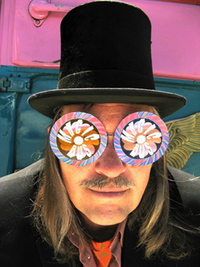 I wish I had enjoyed my tour on Saturday afternoon on The Magic Bus more than I did. But I didn't. The experience left me feeling deflated and slightly nauseous.
I wish I had enjoyed my tour on Saturday afternoon on The Magic Bus more than I did. But I didn't. The experience left me feeling deflated and slightly nauseous."Magic Bus?" said the friend who joined me for the 90 minute ride through time and space back to 1960s San Francisco organized by the normally innovative site-specific theater company, Antenna Theater. "Tragic Bust, more like."
This is perhaps overstating things a bit. The conceit is a marvelous one, at least. What better way to explore a time in this country's history when groups of flower children traveled around the land on brightly-painted buses than by hopping on a bus tricked out to resemble the type of vehicle that the hippies rode in? And knowing whether you were "on the bus" or "off the bus" in the metaphorical sense defined you as an American in some ways during the era, so watching the story unfold while traveling on a bus makes sense.
But despite the strength of the core idea, The Magic Bus fails in two ways: 1) It doesn't go beyond presenting stock notions of the 1960s that people have seen and heard millions of times before such as footage of the Beatles singing "All You Need is Love", the murder of President Kennedy and hippies lounging on the roofs of buses, and 2) Because the entire ride through such touristy neighborhoods such as North Beach, Chinatown, Golden Gate Park and The Haight happens with video projection screens covering the windows most of the time, you feel like you could be seeing the presentation just as easily in a regular movie theater or at home on TV. If you did, you'd certainly feel less sick.
It wasn't all bad: I liked the fact that many of the people on the bus sang along with the songs. Handing out candy and flowers for us to wear in our hair was a nice touch too.
But by the time we returned to Union Square, I was only too happy to get off the damn bus.
 Berkeley Repertory Theatre's presentation of The Great Game: Afghanistan, a cycle of plays about the war in Afghanistan and its historical and political roots written by 12 playwrights and commissioned by the UK's Tricycle Theatre, is an ambitious undertaking to say the least. Directed by Nicholas Kent and Indhu Rubasingham, the plays are organized into three parts and can be viewed on separate evenings, or, as was the case on Friday when I attended, a full-on, all-day marathon with breaks for lunch and dinner.
Berkeley Repertory Theatre's presentation of The Great Game: Afghanistan, a cycle of plays about the war in Afghanistan and its historical and political roots written by 12 playwrights and commissioned by the UK's Tricycle Theatre, is an ambitious undertaking to say the least. Directed by Nicholas Kent and Indhu Rubasingham, the plays are organized into three parts and can be viewed on separate evenings, or, as was the case on Friday when I attended, a full-on, all-day marathon with breaks for lunch and dinner.The cycle is compelling enough to hold our attention: Most of the performances are well-observed and some of the writing is dramatically compelling. I particularly enjoyed "Miniskirts of Kabul" a play by David Greig, for its playful creation of an imaginary meeting between an English female writer (played by Jemma Redgrave) and Mohammed Najibullah, the fourth and last president of the Soviet-backed Democratic Republic of Afghanistan. Unlike many of the others in the cycle, this drama attempted to go beyond teaching a history lesson to theatre audiences. I also enjoyed the ways in which the separate mini-dramas (created by such well-respectedplaywrights as David Edgar, Lee Blessing and Colin Teevan) occasionally reflected upon each other, thus bringing certain themes and ideas to the fore. For example, I was very much taken with how some of the plays explored the notion of cartography -- whether a map merely describes the world or is an attempt to create it in some respect, ie by delineating borders between nations. Another interesting theme comes in the form of a recurring question that pops up in several of the playlets: "Why are you here?". This is perhaps the binding motif of the plays. I liked the way in which some of the plays balanced asking this question in the spiritual/metaphorical sense of the expression with thinking about the different methods people in Afghanistan, both native and foreign, use to rationalize their actions in the country.
Yet despite the few interesting ideas that floated to the surface of this sprawling theatrical journey to a forbidding and socio-politically complex yet culturally rich land, I didn't get a whole lot out of The Great Game in the end. The plays touch on too many cliches regarding modern war zones and trade in conventional ideas about history, eg that it tends to repeat itself, without going beyond the surface. A friend of mine, who attended the cycle on the same day that I did, pretty much summarized his feelings in an email to me the next day. As his thoughts are so very close to my own, I asked him if I could share them on my blog and he kindly agreed:
"Ultimately, it made me feel not at all mad but sad and disappointed that so much time, effort and money would go into something that really doesn't have much impact at all that I can tell and is rather underwhelming. With such an important subject, it is a particular shame. That said, I do still feel it's a bit much for us to expect any artist, even David Edgar, to come up with anything profound to say about the situation or history of Afghanistan. It is a cliche now, that's a part of the problem. What's new to be said? Stay? Go? Let them draw their own borders? Draw borders for them? Poetic, wise locals? Barbaric locals? Blustery Brits and dumb Americans? Well-intentioned Brits and Americans? It's all true and cliche and old news."
My friend also shares my view that if Tricycle had created one long, focused play that went deep into the heart of the subject rather than a cycle of unrelated and diffuse short dramas, the impact would have been greater. "We could have gotten to know some characters and gone through something with them," he wrote in his email.
But we're both glad to have spent the day at Berkeley Rep nonetheless. It was an adventure and I take my hat off to the company for bringing this theatrical behemoth to the Bay Area.
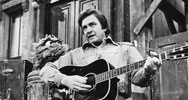 It was a tough decision to make -- and stick to. The Giants were heating up AT&T Park and inching ever closer to victory (for the first time, I am told, in years); The Alonzo King Lines Ballet was packing them in for its fall season at Yerba Buena Center for the Arts. There were all manner of rehearsals, performances and late-night art exhibitions I could have been at last night.
It was a tough decision to make -- and stick to. The Giants were heating up AT&T Park and inching ever closer to victory (for the first time, I am told, in years); The Alonzo King Lines Ballet was packing them in for its fall season at Yerba Buena Center for the Arts. There were all manner of rehearsals, performances and late-night art exhibitions I could have been at last night.And what did this culture critic do? I went to see a documentary about singing puppets.
Sing! The Music of Sesame Street is a sometimes touching and often hilarious romp through 40 years of songs from the famous children's TV show. The little movie theater at YBCA was only half full of people like me in their 30s and 40s. But I got a lot out of the experience beyond the obvious nostalgia factor.
The film, which is part of a month-long movie tribute at YBCA to Muppet creator Jim Henson, consists of footage from the series interspersed with occasional title cards to denote how different songs have been organized by the filmmakers. It's ridiculously simple in scope. There is no narration and no "behind-the-scenes" footage. All we get is 82 minutes of musical numbers performed by a mixture of marionettes and humans. I would have enjoyed more substance to the film beyond the songs, but I also enjoyed the way in which the documentary lets the music really speak for itself.
What I primarily got from the film was a remembrance of how much I learned from these songs as a child. I remembered learning to count with The Count and the difference between 'around', 'over', 'under' and 'through' from Grover running around a pair of swinging saloon doors. I'm also certain that I learned how to distinguish between different ideas and objects in part by singing along with the ditty "one of these things is not like the other..." In short, this was a trip into a corner of my early educational process, a journey into the roots of my cognitive process, if you will.
The simple melodies are very singable. And the messages are often educational without being boring and didactic. Listening to these songs with grown-up eyes, I see how funny and clever they are. In a song that Kermit sings from a perch in the middle of a pristine lake, for instance, a chorus of bug-eyed, orange fish join the frog in singing about the pleasures of greenery, clean air and quietude. As they're singing their bucolic song, a noisy family shows up and starts to throw trash around and drown out the frog and fishes' bucolic song with loud music from a ghetto blaster. Then a speedboat roars past, blocking our view of Kermit and almost killing the fish. As such, the song provides a witty and hard-hitting way of explaining the importance of environmental care. Adults and children alike learn quickly from this and have fun in the process.
In short, despite my feelings of guilt about sitting in a cinema watching footage of Oscar the Grouch singing a duet about unpleasant people with Johnny Cash, I don't regret last night's decision at all.
 I'm teaching a class this semester on 21st century composers and their music at UC Berkeley. The class is being run under the auspices of the Osher Learning for Life Institute (OLLI), an organization which specializes in offering educational courses on a wide range of subjects to older members of the community, and the Berkeley Symphony, which recently appointed me as its resident dramaturg.
I'm teaching a class this semester on 21st century composers and their music at UC Berkeley. The class is being run under the auspices of the Osher Learning for Life Institute (OLLI), an organization which specializes in offering educational courses on a wide range of subjects to older members of the community, and the Berkeley Symphony, which recently appointed me as its resident dramaturg.My class is full of interesting characters. One of the most colorful is an energetic 80-year old woman from South America whom I shall call Valerie.
Valerie was apparently very taken with last week's class all about how we can approach listening to new art music, a music which usually doesn't follow the same rules as the "classics" that most of OLLI's audience are familiar with ie the works of Mozart, Beethoven and Bach.
Valerie was jumping up and down with excitement at the end and practically danced her way through a practical exercise in which the students were instructed to use paper and pencil to create a graphical representation of a short piece of music by the Bay Area-based composer Gabriela Lena Frank as they listened. I was excited to see how moved Valerie was by Gabriela's music. She responded to it in an overwhelmingly visceral way.
Fast forward a week: Yesterday, when I turned up to class, one of the assistants delivered a letter into my hands. It was from Valerie. Before I had time to read it, Valerie herself showed up, with more words of unmitigated enthusiasm about the class and about the music that had so moved her in particular -- Gabriela's music. At one point she said, "I love your music so much..." which at the time struck me as slightly odd, as I had clearly mentioned that the pieces I played during the class were all by Gabriela. But I dismissed the comment, thinking perhaps that Valerie, not being a native English speaker, had simply used an ambiguous turn of phrase.
When I finally got a chance to read her letter, though, it became clear to me that somehow Valerie hadn't cottoned on to the fact that the entire class was based on the music of Gabriela Lena Frank, even though I had made that point very clear throughout. (Gabriela was supposed to have given the lecture herself, but being delayed in Houston owing to flight issues, I had taught the class solo on her behalf and used samples of the Grammy Award-winning composer's music to illustrate the main points we planned to get across.) For some bizarre reason, Valerie thought that I was the composer of the music she heard that day. "Your music, Ms. Veltman...can help me," Valerie wrote. "Please, continue your work. Your piece can be choreographed. It would integrate feelings, movement, colors and singing."
It's funny how muddled I feel by Valerie's words. Her letter is so passionate and beautifully written. I want to share it with Gabriela and my colleagues at the Berkeley Symphony and OLLI. But Valerie clearly somehow got in a muddle and mistook the person who presented the class (ie, yours truly) with the composer herself. I'm really not quite sure how this happened. I certainly never misrepresented myself to the students but I'm slightly embarrassed about the whole thing!
Sheesh. Well, I guess Valerie is 80 years old. As vivacious as she is, perhaps some details pass her by. When I see her next, I'll try to set her straight. Or maybe I'll write her back and include some of Gabriela's recordings on CD for her to dance to whenever the mood takes her.
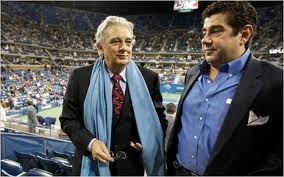 Baseball was clearly in the air at San Francisco Opera yesterday afternoon. Besides the fact that a few of the journalists present at the press briefing with Placido Domingo had just come from the ballpark where, among other things, they had heard the actress Zooey Deschanel sing "God Bless America," there seemed little real reason for that to be the case.
Baseball was clearly in the air at San Francisco Opera yesterday afternoon. Besides the fact that a few of the journalists present at the press briefing with Placido Domingo had just come from the ballpark where, among other things, they had heard the actress Zooey Deschanel sing "God Bless America," there seemed little real reason for that to be the case.Nevertheless, sports analogies flew backwards and forwards at the briefing like we were watching a commentary from the ballpark rather than listening to one of the world's greatest living singers discussing opera.
At one point, Domingo compared the job of a tenor to that of a pitcher in a baseball game. At another, David Gockley spoke of the doubts that television executives had about airing professional sports on TV back in the day and compared it to the doubts that they have about putting opera on the small screen today. Domingo's final statement went something like this: "My dream is that see the opening night of the season at San Francisco Opera or La Scala or The Met from their home."
I know that Domingo is a sports fan and that SF Opera has enjoyed a partnership with the local ballpark over the past five years with its free outdoor simulcasts of productions beamed to audiences of more than 30,000 from the War Memorial Opera House. But the press event overemphasized the power of the Great Game a little too heavily for my taste.
 The journalist Farhad Manjoo (one of my favorite commentators on new media and technology in general) has written a terrific piece in Slate about how the line between blog posts and articles is beginning to blur.
The journalist Farhad Manjoo (one of my favorite commentators on new media and technology in general) has written a terrific piece in Slate about how the line between blog posts and articles is beginning to blur."The design shifts--with blogs looking more like magazines, and magazines looking more like blogs--aren't just superficial. These changes in presentation are collapsing all distinctions between "blog posts" and "articles," writes Manjoo. "What's more, the lines are blurring--blog posts are looking more like articles, and articles are looking more like blog posts...So what's the difference--what's a blog post, what's an article, and does it make any difference vis-à-vis how you navigate the Web?"
I've long maintained that the essential difference between a blog post and an article is that a blog post is a sort of fast riff on a subject that isn't necessarily governed by the usual rules that govern traditional publishing such as word-lengths, multi-perspective reporting and deadlines. A blog post can be about anything. It can skim the surface or go deep depending on the preference of the author. There doesn't even need to be a news peg. And bloggers, in the traditional view, are their own editors. They make up the rules and bear the full brunt of the fallout for what they write.
On the other hand, I've generally thought of articles as being pre-meditated, more carefully researched and fully reported pieces that appear in media outlets beyond my own self-published blog. I am always paid for articles I write, but I do not get paid for blogging. And there are always gatekeepers shaping my articles. Article ideas have to be approved by editors. The editors also contribute (sometimes heavily) to the final look and feel of the story. An article is a team effort whereas a blog post isn't.
Manjoo's piece is interesting because it makes explicit the changes that are occurring in the media industry now that blogs have become a core part of many traditional media outlets' operations and blog-centric enterprises like Gawker turning profits. Gawker and entities like it are able to pay their bloggers salaries because blogs, particularly those about popular topics such as political and social gossip, cars, sex and sports are garnering so many millions of eyeballs which translates into advertising dollars.
As an arts blogger, I continue to maintain my own codes for what constitutes a blog post versus an article. But I do this partly out of financial necessity: until I can make a living from writing an arts blog, I can only devote so much time to researching and writing it. I also feel that the riffing, off-the-cuff nature of a blog post, is something to be prized. There's room for both kinds of writing -- the fast and dirty, and the slow and carefully researched -- in the world of words.
I've a feeling that it won't be long until my approach will seem super old-fashioned, though. Or maybe, because of the non-remuneratory nature of most arts blogs, the arts blogging world will stay behind other more wealthy areas of the blogging community. Those guys may well, as Manjoo's story suggests, move to the magazine-like layouts and legions of editors of old-style publishing. That'll be ironic.I wouldn't be surprised if the arts blogging world doesn't get there, at least for a long time. Which may be a good thing.
 I am just about to go off the grid for a few days and am in a festive mood. So I thought I would regale my readers with some terrible jokes about choirs that I dug up on a whim while procrastinating on the Internet recently. I'll be back in the blogging saddle next week sometime. For now, read these and be happy you're not a chorister. Or if you are, be happy you have a sense of humor about it...
I am just about to go off the grid for a few days and am in a festive mood. So I thought I would regale my readers with some terrible jokes about choirs that I dug up on a whim while procrastinating on the Internet recently. I'll be back in the blogging saddle next week sometime. For now, read these and be happy you're not a chorister. Or if you are, be happy you have a sense of humor about it...Q: Dad, why do the singers rock left and right while performing on stage?
A: Because, son, it is more difficult to hit a moving target.
Q: How many altos does it take to change a light bulb?
A: None. They can't get up that high.
Q: Where's a tenor's resonance?
A: Where his brain should be.
Q: What do you call ten baritones at the bottom of the ocean?
A: A good start.
Q: What is the definition of a mezzo soprano?
A: Just an alto with a soprano's attitude
Q: What's the difference between a soprano and the PLO?
A: You can negotiate with the PLO.
Q: How do you tell if a bass is actually dead?
A: Hold out a check
Q: Why do high school choruses travel so often?
A: Keeps assassins guessing.
Q: What's the definition of an optimist?
A: A choral director with a mortgage.
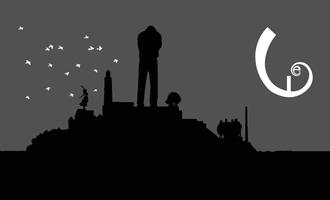 By far the best thing about attending We Players' production of Hamlet is the location. I am not sure how the small, non-profit theatre company managed to swing the insane logistics involved in undertaking such a project. But We is somehow pulling off a walk-through production of Shakespeare's tragedy on The Rock through November 21st.
By far the best thing about attending We Players' production of Hamlet is the location. I am not sure how the small, non-profit theatre company managed to swing the insane logistics involved in undertaking such a project. But We is somehow pulling off a walk-through production of Shakespeare's tragedy on The Rock through November 21st.The use of the space is remarkable. The opening ghost scene takes place on the ramparts of the main block, with the audience watching from far below as Hamlet and his cohorts scamper about trying desperately to comprehend the sight of the Prince's dead father, refracted eerily through the presence of several figures standing motionless in black jumpsuits and white head coverings. The Mousetrap scene takes place in a cell area, with the audience crammed behind bars while the scene change occurs in the walkway between the cells. And Claudius' private confession of guilt in the chapel transpires in the mouth of a hidden tunnel close to a rusty mammoth water tower with a giddy view of the Golden Gate Bridge and city lights behind him.
If only the acting were on a par with the setting. The voluntary cast gives a great deal -- they play with undeniable commitment and passion. But there is no subtlety or nuance in their performances. Obviously the acting has to be "large" in the opening outdoor scenes when the actors have to contend with ferry noise and other daytime distractions. But all the scenes, whether played indoors or outside, are communicated at such a fraught and feverish pitch that the play soon becomes exhausting and ultimately tedious to watch.
Still, simply getting a chance to experience parts of the island prison that members don't ordinarily get to see makes this Hamlet a worthwhile adventure.
 One of the key reasons that directors and producers choose to stage classic dramas written in a past era is for their function as prisms through which we can view the issues and challenges of our own time. Audiences in Shakespeare's day were, in addition to having a rollicking good time, encouraged to see the parallels between, say, the trials of Henry IV and the tumultuous political and religious power tactics going on at the upper echelons of their country at that time.
One of the key reasons that directors and producers choose to stage classic dramas written in a past era is for their function as prisms through which we can view the issues and challenges of our own time. Audiences in Shakespeare's day were, in addition to having a rollicking good time, encouraged to see the parallels between, say, the trials of Henry IV and the tumultuous political and religious power tactics going on at the upper echelons of their country at that time.I was thinking about this as I watched Mark Jackson's mostly riveting adaptation of Friedrich Schiller's Mary Stuart at Shotgun Players' Ashby Stage on Friday night. The drama has a lot of contemporary appeal because of its portrayal of the fraught relationship between two monarchs. One clearly has the upper hand from a power perspective (Queen Elizabeth I), and the other, Queen Mary of Scots, though suppliant, is a force in her own right for her ability to move men to undertake rash deeds on her behalf.
The American Conservatory Theater did the play not too long ago; there was a recent production from London's Donmar Warehouse starring Janet McTeer and Harriet Walter which visited Broadway.
Unlike the McTeer/Walter version which I saw on Broadway and found to be dry and slow, Jackson's production is thrilling. I loved the taut-lyrical text which balances a contemporary feel with a timeless lyricism, the simmering rage of the characters, the rigorous and compelling performances from all members of the cast -- without exception -- and moments of gravelly humor. The push-pull of the relationship between Beth Wilmurt as Queen Elizabeth and Stephanie Gularte as Mary -- actresses who match pride with sensitivity -- keeps us constantly engaged.
Where the production falls short for me is in the decision to bring out the contemporary political parallels in a way that's way too obvious. The "surveillance chic" of the setting -- an austere government screening facility with nondescriptly-painted, flimsy walls, a one-way viewing screen and video screens -- puts the comparison between Renaissance England and modern America too much in our faces.
Part of the power of experiencing a play like this is having to work to draw whatever conclusions you want about contemporary life. Jackson hands it all to us on a platter and leaves little to our imaginations.
 It's gotten to the point where hearing about how fed up people are about the decline of arts reviews in the press is becoming boring and not helpful in terms of finding a solution to replace the loss.
It's gotten to the point where hearing about how fed up people are about the decline of arts reviews in the press is becoming boring and not helpful in terms of finding a solution to replace the loss."I miss newspapers," gripes Ron Evans in a recent blog post on the Arts Marketing Bog Salon. "No, I know we still have some daily, weekly, and other newspapers around the country (and my hat goes off to those still working in this field. I also miss hats). But the decline of arts journalism has been massive over the last few years. There are only a few newspapers left in the country that have dedicated arts reviewers/writers - writers who can be trusted to at least publicly declare that they continue to follow journalistic standards. And that's sad. It's sad, because nothing good has risen up to replace them."
I heard a similar cri-de-coeur this morning in a phone interview with the head of a cabaret organization in New York, who blames the loss of media coverage as playing a major role in killing off cabaret as an art form and cabaret venues. And I feel like I hear or read similar complaints every day.
People have been voicing such laments for about a decade now. Chafing at this point isn't going to bring back full-time arts critics at all the newspapers. It won't even bring back the newspapers. The fact is that the media landscape is irrevocably changing and we need to look to new alternatives for trusted, engaging writing and thinking about the arts. The blogosphere is full of people who aren't trustworthy as commentators. But I don't think it'll be long before trustworthy commentators rise to the top. It just takes time and patience for this to happen.
 I just got the following email from a friend about In the Red and Brown Water, the first part of The Brothers/Sisters Plays, a trilogy of dramas by Tarell Alvin McCraney (pictured). The trilogy is currently being rolled-out in three Bay Area theatres:
I just got the following email from a friend about In the Red and Brown Water, the first part of The Brothers/Sisters Plays, a trilogy of dramas by Tarell Alvin McCraney (pictured). The trilogy is currently being rolled-out in three Bay Area theatres:"By the by," wrote my friend. "Have you seen In the Red and Brown Water at Marin Theatre Company? You should. It's incredible."
I've been hearing words like "amazing" and "incredible" applied not just to this play, but also to The Brothers Size, the middle play in the trilogy, which I caught last night at The Magic Theatre. The third play, Marcus: Or the Secret of Sweet, opens at ACT on October 29.
I'm sorry to say that I didn't enjoy The Brothers Size at all.
I wonder if I needed to see the Marin play to appreciate the Magic one? I think not though, because I've heard that all the plays stand alone as individual units as well as a three-part whole. Plus, the issues I have with "the middle child" have little to do with thematic, narrative or character stuff that would only make sense when thought about in relation to the two plays that bookend this drama.
The play only lasts 90 minutes, but director Octavio Solis' production plays itself out in one exhausting style: Loud. The Magic Theatre is an intimate space, but the three-strong ensemble felt the need to shout their way through the entire play. There is no quiet place to reflect on any of the action. I don't appreciate McCraney's conceit of having the characters announce their movements in the third person every now and again, as if reading the stage directions out loud (e.g. "Ogun Size Exits.") What's the point? The self-conscious technique doesn't to my mind reveal anything about the relationships between the characters or the deeper themes about brotherhood in the play. And the karaoke scene in which the brothers dance and sing to a cheesy Motown track ("Try a little Tenderness") is simply embarrassing. Finally, I'm getting a little bored of dramas featuring people of color who are either on their way to prison, in prison or recently paroled from prison. Enough with the cliches.
I'd like to get over to Marin to see the first play in the cycle before it closes. But I'm not sure I'll manage it. Perhaps at least I'll get to ACT to see the end out.
I am impressed with the way in which the three companies are collaborating on this project. It's a great way to get audiences connected to a bunch of theatres and introduce them to the work of a "hot" new playwright. And certainly, McCraney's dramas seems to be touching audiences who've seen either or both of the first two plays thus far. Perhaps there's something wrong with me?
 I've devoted several episodes of VoiceBox, the weekly public radio series on KALW 91.7 FM all about the human voice which I host and produce, to the subject of voice therapy. But all the conversation about nodes on the vocal folds, dealing with fatigue by maintaining good airflow and how voice changes with age didn't hit home until I visited the University of California at San Francisco's Voice and Swallowing Center yesterday for a consultation with vocal therapist Sarah Schneider (whose been my guest on VoiceBox three times to date) and otolaryngologist, Dr. Mark Courey.
I've devoted several episodes of VoiceBox, the weekly public radio series on KALW 91.7 FM all about the human voice which I host and produce, to the subject of voice therapy. But all the conversation about nodes on the vocal folds, dealing with fatigue by maintaining good airflow and how voice changes with age didn't hit home until I visited the University of California at San Francisco's Voice and Swallowing Center yesterday for a consultation with vocal therapist Sarah Schneider (whose been my guest on VoiceBox three times to date) and otolaryngologist, Dr. Mark Courey.I think it behooves all singers, whether they have voice issues or not, to get their vocal folds checked out at least once in their singing careers. Because all the apparatus involved with singing is internal, it really helps to be able to see first-hand with your own eyes how the mechanisms actually work.
In my consultation, Sarah felt my adam's apple and throat muscles, photographed my profile while I read out a "phonetically balanced" passage (ie one where the sentences are chosen so that the various segmental phonemes of English are represented in accordance with their frequency of occurrence) and, best of all, performed a videostroboscopy on my vocal chords while I sang various parts of the major scale to different vowel sounds.
It was absolutely fascinating (and mildly shocking) to see my vocal folds opening and closing like the mouth of some ancient sea creature grazing for plankton on the ocean floor. I learned a lot about how the voice works and have a better grasp of the issues that I face with my voice at the moment.
The session ended with a consultation with Dr. Courey. I don't think I will ever view the activity of singing in the same way again.
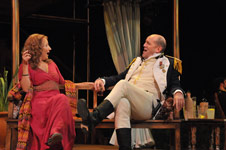 A few months ago, following a trip out to Orinda to see G B Shaw's Mrs Warren's Profession at the California Shakespeare Theatre's Bruns Amphitheatre, I wrote a snarky blogpost about how I felt the location's souped-up, shiny new ticket office, concession stand, toilets and landscaping spoiled the rustic feel of the lovely outdoor venue.
A few months ago, following a trip out to Orinda to see G B Shaw's Mrs Warren's Profession at the California Shakespeare Theatre's Bruns Amphitheatre, I wrote a snarky blogpost about how I felt the location's souped-up, shiny new ticket office, concession stand, toilets and landscaping spoiled the rustic feel of the lovely outdoor venue.I now owe California Shakespeare Theatre an apology for being so rude about its face-lift.
What I failed to see on that visit to the theatre was that the upgrades aren't merely all about making cosmetic changes to please the subscribers.
On a trip over this past weekend to see Jonathan Moscone's production of Much Ado About Nothing (which is excellent by the way owing in large part to the spunky tug-of-love between Andy Murray's Benedick and Dominique Lozano's Beatrice, though the decision to turn Don John into a campy clown is an odd one) I was given a short tour of the backstage renovations at the Bruns Amphitheatre by the organization's managing director, Susie Falk.
Susie took me to areas of the property which are hidden from audience members' view. It was only when I glimpsed the contented cast members lounging on comfy sofas in a clean, dry, warm and well-lit green room, and costume staff happily applying straightening irons to wigs in an airy costume space, that I realized how much of an improvement to the lives of Cal Shakes' actors and staff the upgrades make.
In the past, the behind the scenes areas were dark, damp, cramped and cold. The production team members suffered unduly for their art.
The theatre still has some way to go in its improvement plans and I wish them every success in raising the necessary funds to create a new lighting and sound booth which complies to code and various other key projects.
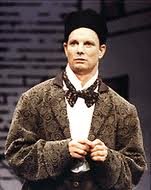 As a theatre critic, I generally have a policy that if I find myself feeling negative about the work of a single company over several shows, I'll give seeing productions by that company a break and then go back and check another show out after some time has elapsed. This helps to "reset the clock" so to speak. There's no point in harping on over and over again about how terrible one organization's work is. That gets dispiriting and discouraging for readers and writer alike. It tends to annoy the artists too.
As a theatre critic, I generally have a policy that if I find myself feeling negative about the work of a single company over several shows, I'll give seeing productions by that company a break and then go back and check another show out after some time has elapsed. This helps to "reset the clock" so to speak. There's no point in harping on over and over again about how terrible one organization's work is. That gets dispiriting and discouraging for readers and writer alike. It tends to annoy the artists too. In the case of the American Conservatory Theatre, I've kept going to shows, even though I've mostly been disappointed. The reason for this is that the company is the Bay Area's flagship theatre organization and therefore deserves to be be under closer scrutiny than other organizations in the region.
So it was with some trepidation that I took myself off to see Scapin at ACT over the weekend. Directed, co-adapted and starring Bill Irwin, I guessed that the production had to have some merit to it.
But given ACT's reputation for hashing up the output of artists who otherwise are known for making terrific work (e.g. the ill-advised Tosca Project collaboration with the San Francisco Ballet and John Doyle's tiresome production of The Caucasian Chalk Circle) I wasn't convinced that even the brilliant Bill Irwin could escape the clutches of the Geary Stage unscathed.
But the mercurial theatre artistic managed extremely well, pulling off a show that is as slick and smart as the title character of Moliere's comedy.
The best thing about ACT's Scapin is how Irwin improves the game of all of ACT's actors. Every single member of the cast (bar one, who is in a small role that isn't well-suited for her) acted better than I have ever seen them act. Who knew that Jud Williford was such a consummate clown? He is so funny and physically lithe in the role of Scapin's sidekick Sylvestre that he almost steals the limelight from Irwin himself. The production made me truly understand what a terrific actor Williford is.
The strong sense of ensemble, the Vaudeville-inspired physical poetry of the piece, the ribald sense of humor, the salty-smart adaptation and the witty piano and drum live musical score made for the most engaging home-grown evening I have spent to date at the Geary Theatre. This Scapin is even on a par with some of the captivating imports that ACT has brought in in recent years such as CanStage's The Overcoat and Kneehigh Theatre's Brief Encounter. Let's hope that more ACT-generated shows can match the strength of Scapin in future.
 1. More opera websites should provide information about their choruses. Notices about auditions and lists of singers don't provide enough detail about how these important musical organizations work. I'd like to see opera websites publishing information about the history and development of their choruses, important milestones in their pasts, production photos, information about life backstage for chorus members and what it's like to audition and rehearse with an opera chorus. I say this because I just recorded a VoiceBox show last night on the subject of opera choruses with the San Francisco Opera's wonderful music director, Ian Robertson, and was dismayed to find so little information available on the Web on the subject. There isn't even a Wikipedia entry for opera chorus.
1. More opera websites should provide information about their choruses. Notices about auditions and lists of singers don't provide enough detail about how these important musical organizations work. I'd like to see opera websites publishing information about the history and development of their choruses, important milestones in their pasts, production photos, information about life backstage for chorus members and what it's like to audition and rehearse with an opera chorus. I say this because I just recorded a VoiceBox show last night on the subject of opera choruses with the San Francisco Opera's wonderful music director, Ian Robertson, and was dismayed to find so little information available on the Web on the subject. There isn't even a Wikipedia entry for opera chorus.2. I'm excited to hear about the new Emmy Award-winning documentary about the choral arts in Minnesota, Never Stop Singing (screenshot above). Seems like getting hold of a copy of the documentary might be tricky however, owing, of all ridiculous things, to the unions behind the orchestras that appear in the film backing up the singers. The documentary's website says: "Notice to viewers: We are unable to offer DVDs for sale to the general public, due to the contractural agreements with the professional orchestras that appear in the program. However, DVDs are available to Minnesota choral conductors and libraries at no cost." I wonder if people outside of Minnesota can see the film? I certainly hope so.
